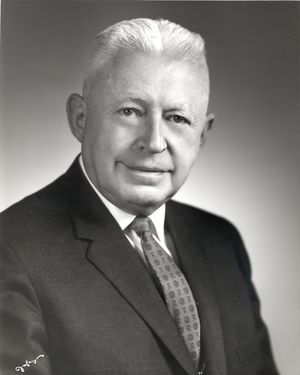
Westcott descendant Lawrence Marshall Robertson (January 20, 1900 to July 23, 1988) was an internationally recognized electric utilities engineer. He was known for his cutting edge research into transmission line performance at high altitude and the risks from lightning, high winds, fire and extreme cold, as profiled in the selection from Engineering and Technology History Wiki below.
Robertson was the son of Hugh L. Robertson and Grace (Worden) Robertson and an eleventh generation descendant of Stukely and Juliana Westcott: Lawrence Marshall Robertson12, Grace Pamela Worden11, Henry Isaac Worden10, Mary Fanny Remington9, Henry John Remington8, Sallie Bliss7, Benedict Bliss6, Henry Bliss5, Josiah Bliss4, Damaris Arnold3, Damaris Westcott2, Stukely Westcott1.
After serving in the U.S. Army during World War I and then earning the first of several degrees from the University of Colorado, Robertson married fellow alum Mildred Blackwood (1901-1971) on November 15, 1924. They had one child, Lawrence Robertson, Jr. and spent most of their lives together in the Denver area. Lawrence Marshall Roberston died on July 23, 1988. Here is his profile in Engineering and Technology History Wiki:
Lawrence Marshall Robertson was born in Denver, Colorado on January 20, 1900. He received the Bachelor of Science degree 10 Electrical Engineering from the University of Colorado in 1922, the degree Electrical Engineer in 1927, and the Master of Science degree in Electrical Engineering in 1938. In 1930 he received the degree Bachelor of Law from Westminster Law School “For outstanding contributions in both his civic and professional life,” he was awarded the honorary degree, Doctor of Engineering, by the University of Colorado in 1955. He joined the Public Service Company of Colorado in 1922 and was Manager of Engineering for that company. He resided in Denver, Colorado.
Dr. Robertson was an internationally recognized authority in the fields of electric utility engineering and transmission line research, particularly phenomena at high altitudes. The Leadville High Altitude Test Line, which he conceived and directed, is but one of his many transmission line research projects which have contributed significant data on such subjects as lightning discharge currents, temperatures on the earth’s surface, rate of rise of lightning stroke currents, and transmission line corona loss and radio noise, all at high altitudes. He has published more than 45 technical papers and reports describing and enumerating the results from these research projects and other technical interests.
Dr. Robertson has supervised the electrical engineering of some of the largest private power developments in the West. Examples of these are substations totaling 2,239,926-kva in capacity, 705 miles of 115-kv transmission lines, 327 miles of 69-kv, 213 miles of 44-kv, 76 miles of 230-kv transmission line, and steam power plants totaling 887,350-kw in capacity all for his own company. He has served as a consultant to neighboring utilities on transmission line design and system planning.
For many years, Dr. Robertson has taken an active part in the technical, operational, and administrative phases of the American Institute of Electrical Engineers, and the Institute of Electrical and Electronics Engineers. He served on the Power Transmission and Distribution, Registration of Engineers, General Systems, Switchgear, Power Generation, Edison Medal, Transfers, Professional Conduct, and Constitution and By-Laws Committees of the Institute. He was responsible for the establishment of the Working Group on Corona and Radio Interferences-High Voltage Transmission Lines and he served as this group’s first chairman. He is a past Section Chairman, national Vice-President, and national Director of the Institute. He also served on the 14-man merger committee of AIEE and IRE to form the new IEEE. He has been a Fellow since 1945.
His contributions to engineering have extended beyond IEEE through his participation in many other societies including the Conference Internationale des Grande Reseau Eleariques of Paris, Edison Institute Electric Equipment and Research Projects Committees, Professional Engineers Society of Colorado, Colorado Society of Engineers, Colorado Engineering Council, American Geophysical Union, and the Rocky Mountain Electrical League. While president of the Colorado Engineering Council he was instrumental in having legislation important to engineers passed by the Colorado legislature. He has been a member of the Colorado State Board of Registration for Professional Engineers and Land Surveyors since 1954 and is presently the Chairman of this group. A special recognition of Dr. Robertson’s prestige and competence was given when he was asked to serve on the General Technical Advisory Committee of the Federal Power Commission by Mr. Joseph C. Swidler, Chairman of the Commission. The goal of this committee is “to project in broad outline a nation-wide power supply system for the years ahead through 1980.”
Lawrence Robertson and his wife, Mildred, have one son, Lawrence M. Robertson, Jr. In addition to his many professional activities, he has found time to participate in civic affairs. He is an Advisory Board Member for the Denver Public Library and a “spark plug” of the Colorado University Development Fund Committee. He has been a director of the Colorado Chamber of Commerce and of Boy Scouts of America and is an active layman in his church.
Dr. Robertson ‘s engineering and civic accomplishments have received widespread recognition. He is one of six men who have been honored with the Gold Medal Award for engineering achievement of the Colorado Engineering Council. In the opinion of his many friends and associates he is highly deserving of the 1963 Habirshaw Award.
